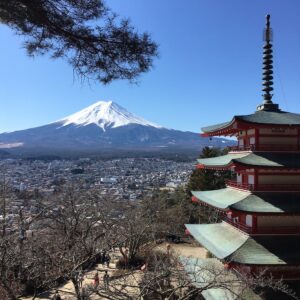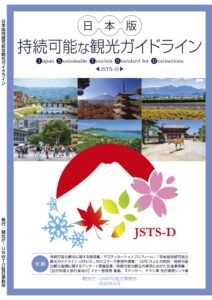It’s a tall order for a large country to change its national policy and commit to improving stewardship for hundreds of its tourism destinations, but Japan is taking tentative steps in that direction, spurred on by one young official and a lot of collaborators. GSTC’s Emi Kaiwa reports on how this tentative change of heart came about, what’s happened to date, and how far it has to go.
In 2018, a book left in an office rack snagged the attention of a young Japanese official. Beginning with that moment, Japan, a country of 126.17 million in 20191, finally began action toward sustainability in tourism. In 2020 the Japan Tourism Agency (JTA) decided to adopt the Global Sustainable Tourism Council (GSTC) Destination Criteria as policy and create a national set of guidelines called the Japan Sustainable Tourism Standard for Destinations (JSTS-D)2.
Unwilling to be left behind, Japan is on the trail to becoming a sustainable country with a national program to support its hundreds of tourism destinations. In addition, Japanese Prime Minister Yoshihide Suga declared that Japan will achieve zero carbon emissions by 2050.
How Did This Come To Pass?
Over the past decade, JTA focused on marketing, seeking an ever-increasing number of international visitor arrivals (IVAs),3 while still aiming for a measure of sustainability. The target was for 20 million IVAs by 2020, which was quickly met, and then revised to a goal of 40 million. The Covid pandemic kept this goal from being acheived, but Japan decided to aim for a target of 60 million IVAs by 2030.

This increase might seem contradictory to meeting sustainability goals, but Japan is larger in size than Italy, which received 131 million visitors in 2019 (albeit with some dire overtourism situations). Arguably, Japan has room.For an entire country, economic goals are still as important as sustainability.
It was challenging to impart the importance of destination management to industry stakeholders whose priority used to be marketing. In order to do both, Japan had to find a way to sustainably manage destinations so that they can receive 60 million visitors. The solution came in the form of the GSTC framework, which promoted the idea of destination management [in its Destination Criterion A1] while still supporting economic goals.
The Book and the Man
In 2018, GSTC was not well known to Mr. Hajime Ono, the young Chief Official from Visitors Experience Improvement, JTA. One day, a book4 that “someone” left on the rack in his office caught his eye. It summarized in Japanese a 2017 forum on sustainable tourism. The contents of the book were all about GSTC, which aroused his intense curiosity to learn more.

Understanding the value of GSTC’s comprehensive global standard for managing destinations made him consider the connection between management and overtourism issues. He concluded that the GSTC-Destination criteria could be the broad management tool needed for dealing with overtourism, a critical problem for Japan before COVID-19 arrived. Even if this pandemic stays for a while, the tourism business will bounce back sooner or later.
Japan may in fact have sufficient capacity to receive its goal of 60 million IVAs by 2030. One way is through promoting rural areas as tourist destinations. So is development of transportation infrastructure – airport facilities and mixed-mode commuting to rural areas, accommodation facilities, and tourism resources – that will make it possible for tourists to spread out and visit different regions in Japan. By using information and communication technology, popular destinations can control tourists’ visiting times and mitigate the impact of seasonality.
A plan for comprehensive management of destinations was therefore deemed essential, and adopting the GSTC approach as a tourism policy was the solution. Mr. Ono became the lead in creating the JSTS-D guidelines to comply with GSTC-D criteria. The guidelines employed user-friendly wording, with references and examples, as a way to provide self-guided management at the destination level.
How To Make It Work?
Even though the JSTS-D was based on the global GSTC standard, nationwide penetration at the destination level was going to be quite challenging. How then could the local municipal and Destination Management Organization (DMO) officers be motivated to read the JSTS-D and implement it along with other tourism stakeholders? Fortunately, the United Nations Sustainable Development Goals (SDGs) acted as a catalyst. SDGs have been included in many municipal comprehensive strategy plans and have gained traction in almost all industries year by year. Corporations seem eager to find ways in which they can achieve the SDGs. One is by collaborating with destinations to support them in becoming more sustainable by using the GSTC Industry Criteria (GSTC-I) for tourism businesses.
That “someone” who left the book on sustainable tourism for Mr. Ono was actually one person representing many people who worked hard to get attention from the government for many years. Their earnest effort has borne fruit. Mr. Ono left the Visitors Experience Improvement department in March 2021 and moved to the Office of Director for Travel Promotion. Now, a newly formed organization called “Japan Tourism for SDGs”, which is not government mandate, will take over the initiative from the national government to continue Japan’s journey. This independent organization is led by Mr. Hidetoshi Kobayashi, who has declared that he will spend the rest of his life working for sustainable tourism.
Commentary
JSTS-D is not perfect. There is room for improvement, and that is one of the important characteristics of sustainability. Obtaining a sustainability label does not mean everything is entirely sustainable. Other aspects of improvement will be found in the learning process of getting certified. For now, think what the best approach is to move toward sustainability for the destination. The answer will not be the same, single, perfect solution for every prefecture and municipality. Perfect sustainability cannot be achieved at once, but destinations should keep moving forward patiently, one step at a time.
As the proverb says, Rome was not built in a day, nor was it built by only one man. Accelerating the sustainability movement requires fostering talent, expanding partnerships, and creating a network of people with sustainability mindsets. It might take time and endurance, but it thrives unexpectedly once a destination is ready. Sustainability is a long journey, probably without end, and the government is not the only one to lead its path. Society also needs to keep catching up and adjusting to rapid changes in a globalizing world. On this Earth of limited resources, however, the pathway of sustainability is required to maintain all humankind.
[1]Statists Bureau of Japan. Statistical Handbook of Japan 2020. [Online]. Available from https://www.stat.go.jp/english/data/handbook/c0117.html#:~:text=Japan’s%20total%20population%20in%202019%20was%20126.17%20million[Accessed 23rd November 2020].
[2]Japan Tourism Agency. Japan Sustainable Tourism Standard for Designations (JSTS-D). [Online]. Available from https://www.mlit.go.jp/kankocho/content/001350848.pdf [Accessed 10th January 2021]
[3]Japan Tourism Agency.観光立国推進閣僚会議 「観光ビジョン実現プログラム 2020 -世界が訪れたくなる日本を目指して-. [Online]. Available from https://www.mlit.go.jp/kankocho/content/001353662.pdf [Accessed 10th January 2021]
[4] Japan Eco Tourism Center. 100年先を見すえた観光地域づくりのために 島原半島フォーラム. [Online]. Available from https://ecocen.jp/wp-content/uploads/2018/04/ea3cb83b4770677bfa7ecda0280d78ba.pdf [Accessed 23rd November 2020] *This book was produced by Japan Eco Tourism Center’s grants projects to promote GSTC in Japan since 2015.
~ ~ ~
Thanks to Mr. Ono for his commitment to sustainable tourism initiatives as a government official and his assistance with this report.



2 Responses
Thank you Emi for sharing how Japan has started its journey towards sustainability. I am looking forward to collaborating with the newly formed “Japan Tourism for SDGs” centre to further promote Sustainable Tourism in Japan.
Thank you for your kind comment 🙂 I wish to have more like-minded people like you in Japan. Thanks!!